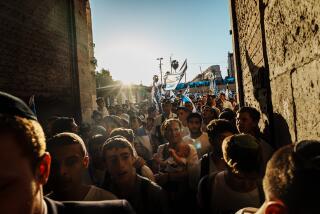Tunnel Opening in Jerusalem Sparks Protests
- Share via
JERUSALEM — Palestinians threw stones and bottles at Israeli police Tuesday to protest Israel’s opening of a controversial tunnel near several of the holiest sites in this disputed city.
The news that Israeli workers had finished excavating the ancient passage linking the Western Wall, Judaism’s most sacred site, and the Via Dolorosa, where Christian tradition holds that Jesus walked to his crucifixion, brought denunciations from Palestinian officials and triggered protests in several areas of East Jerusalem.
Palestinian Authority President Yasser Arafat, speaking at a graduation in the Gaza Strip, condemned the tunnel project as a “crime against [Islamic] religious and holy places” and said it violated the spirit of the Israeli-Palestinian peace process.
Two vehicles--a truck and a rental car--were set ablaze near the main shopping street of East Jerusalem, and police fired rubber bullets to disperse crowds of mostly youthful demonstrators. A spokesman for the Jerusalem district police said 11 people were arrested.
Shopkeepers quickly shuttered their stores and most were expected to observe a call by Islamic leaders to remain closed until noon today.
At one point, Jewish worshipers were briefly evacuated from the plaza near the Western Wall in Jerusalem’s Old City after protesters hurled stones in their direction. Police said the day’s only reported injury was suffered by an officer whose head was grazed by a rock.
Still, the incidents, reminiscent of the Palestinian uprising that preceded the 1993 Israeli-Palestinian peace accord, underscored current tensions between the two sides. And they illustrated the ease with which political confrontation here can flare into violence, particularly in Jerusalem, the city at the heart of the conflict.
The events leading to Tuesday’s protests began shortly after midnight, when Israeli workers under heavy police guard broke through the last foot of stone and opened an exit to the narrow pedestrian tunnel from the Via Dolorosa.
For the past two years, tourists have been able to walk along much of the narrow passage but had to squeeze past each other to return the way they came at the end of the tour.
Ministry of Tourism officials predict that 400,000 people a year--up from the current 70,000--now can visit the tunnel, which includes medieval and Roman vaults and a Maccabean water system constructed about 2,200 years ago.
The tunnel, which traces an ancient roadway, stretches 500 yards beside the Western Wall, all that remains of the Second Temple destroyed by the Romans in AD 70, and alongside the compound known to Jews as the Temple Mount and to Arabs as Haram al Sharif, the “Noble Sanctuary.” The compound houses the Dome of the Rock and Al Aqsa mosque and is the third-holiest site of Islam.
Palestinians fear that the tunnel could undermine the foundations of the structures and other buildings nearby and provide an easy target for extremists who might wish to damage the Islamic holy places.
Several also said the decision to open the tunnel, made by the previous government but put into force under the hard-line administration of Prime Minister Benjamin Netanyahu, was an important symbol, intended to assert Israeli sovereignty over all of Jerusalem.
Adnan Husseini, executive director of the Waqf, the Muslim religious council that administers the Old City’s Islamic sites, said the tunnel’s excavation was in line with the new government’s recent actions to expand settlements on the West Bank and confiscate land from Palestinians in East Jerusalem.
“This is an Arab area and they are trying to impose their sovereignty over it by force,” Husseini said in an interview in his Old City office. “Why did they put it in their minds to open it now? It means the peace is over.”
But not all Palestinians were upset by the government’s action. Several owners of souvenir stands near the new tunnel opening happily echoed the words of Israeli officials, saying they hope the attraction will bring thousands more tourists--and revenue--to the narrow streets of the Old City.
“For us, it’s good,” said Khaled Doneh, standing just outside his closed shop. “It’s nothing against the mosques. It’s for the tourists. And now, more tourists will come.”
More to Read
Sign up for Essential California
The most important California stories and recommendations in your inbox every morning.
You may occasionally receive promotional content from the Los Angeles Times.













